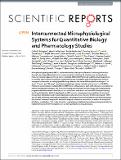Interconnected Microphysiological Systems for Quantitative Biology and Pharmacology Studies
Author(s)
Edington, Collin D; Chen, Wen Li; Geishecker, Emily R; Kassis, Timothy; Soenksen Martinez, Luis Ruben; Bhushan, Brij M; Maass, Christian Alexander; Tsamandouras, Nikolaos; Valdez Macias, Jorge Luis; Cook, Christi Dionne; Yu, Jiajie; Suter, Emily C; Shockley, Michael J; Velazquez, Jason G; Velazquez, Jeremy J.; Stockdale, Linda; Papps, Julia P; Lee, Iris; Vann, Nicholas W.; Contreras Gamboa, Mario e; LaBarge, Matthew E; Zhong, Zhe; Wang, Xin; Boyer, Laurie Ann; Lauffenburger, Douglas A; Carrier, Rebecca; Communal, Catherine; Tannenbaum, Steven R; Trumper, David L; Cirit, Murat; Griffith, Linda G; ... Show more Show less
Downloads41598-018-22749-0.pdf (3.507Mb)
PUBLISHER_CC
Publisher with Creative Commons License
Creative Commons Attribution
Terms of use
Metadata
Show full item recordAbstract
Microphysiological systems (MPSs) are in vitro models that capture facets of in vivo organ function through use of specialized culture microenvironments, including 3D matrices and microperfusion. Here, we report an approach to co-culture multiple different MPSs linked together physiologically on re-useable, open-system microfluidic platforms that are compatible with the quantitative study of a range of compounds, including lipophilic drugs. We describe three different platform designs - "4-way", "7-way", and "10-way" - each accommodating a mixing chamber and up to 4, 7, or 10 MPSs. Platforms accommodate multiple different MPS flow configurations, each with internal re-circulation to enhance molecular exchange, and feature on-board pneumatically-driven pumps with independently programmable flow rates to provide precise control over both intra- and inter-MPS flow partitioning and drug distribution. We first developed a 4-MPS system, showing accurate prediction of secreted liver protein distribution and 2-week maintenance of phenotypic markers. We then developed 7-MPS and 10-MPS platforms, demonstrating reliable, robust operation and maintenance of MPS phenotypic function for 3 weeks (7-way) and 4 weeks (10-way) of continuous interaction, as well as PK analysis of diclofenac metabolism. This study illustrates several generalizable design and operational principles for implementing multi-MPS "physiome-on-a-chip" approaches in drug discovery.
Date issued
2018-03Department
Massachusetts Institute of Technology. Department of Biological Engineering; Massachusetts Institute of Technology. Department of Biology; Massachusetts Institute of Technology. Department of Mechanical Engineering; Massachusetts Institute of Technology. Research Laboratory of ElectronicsJournal
Scientific Reports
Publisher
Nature Publishing Group
Citation
Edington, Collin D. et al. “Interconnected Microphysiological Systems for Quantitative Biology and Pharmacology Studies.” Scientific Reports 8, 1 (March 2018) © 2018 The Author(s)
Version: Final published version
ISSN
2045-2322